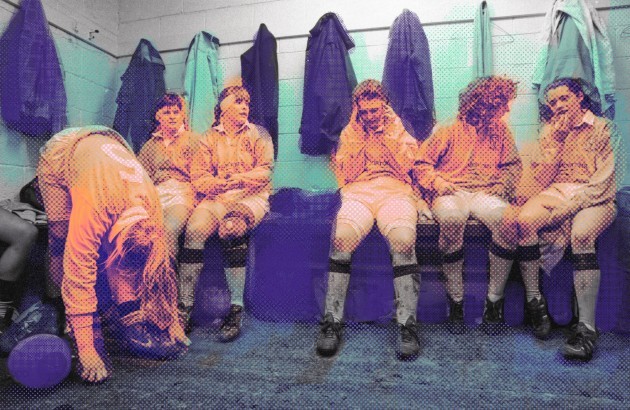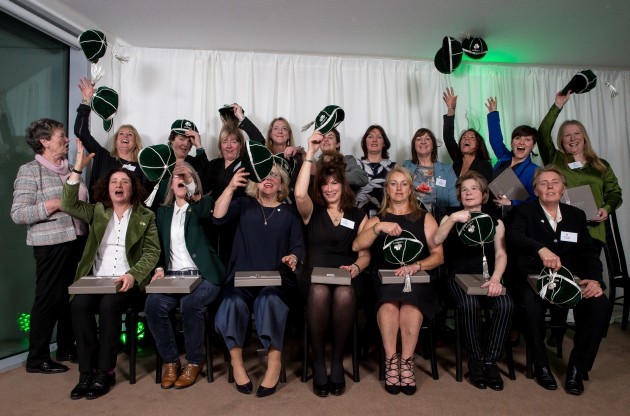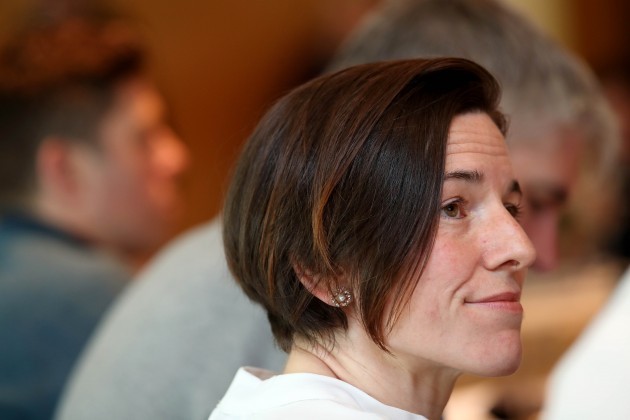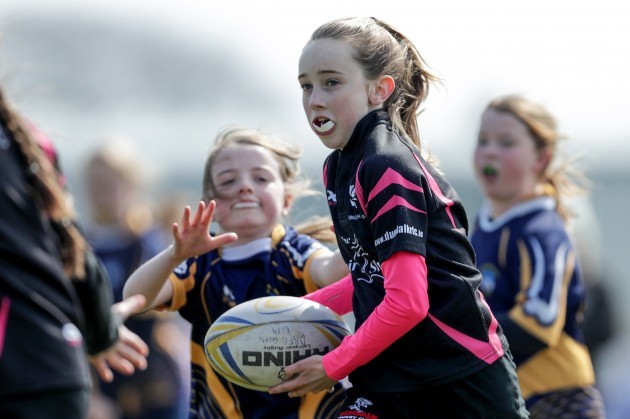LAST UPDATE | 10 Apr 2021
TRAILBLAZERS’ IS OUR new series, telling the unheard stories of the women who fought for recognition in Irish rugby, and those who brought the sport to where it is today.
With Guinness – a proud sponsor of the Women’s Six Nations – The42 will pay tribute to their achievements, shine a light on the challenges they overcame, and look ahead to what’s next for women’s rugby in Ireland.
In the first instalment, Daire Walsh looks at the founding members of the IWRFU, whose groundbreaking move laid the foundations for the women’s game in this country.
We used to get a really hard time for playing rugby. There was a certain stereotype about us” - Carole Ann Clarke
In February 1992, a determined group gathered in the living room of Mary O’Beirne’s house in south Dublin to put the wheels in motion for an exciting new venture that would change the landscape of women’s rugby in Ireland forever.
Very much at an embryonic stage in Ireland at the time, the game was prevalent in countries such as France, the USA and Spain during the 1970s, but it didn’t start to take hold on these shores until the following decade.
There were roughly 10 teams playing the sport by the end of the 1980s and while the first Women’s Rugby World Cup took place in 1991, Ireland were marked absent.
The first meeting
A physiotherapist with her local club Blackrock College, O’Beirne played host for the inaugural meeting of the Ireland Women’s Rugby Football Union (IWRFU).
O’Beirne was to be the first President of this independent body, with Joanne Hall and Suzanne Corcoran taking on the roles of Secretary and Treasurer respectively.
Her clubmate Carole Ann Clarke was to become involved shortly after this original get-together before later assuming the mantle of IWRFU President in 1999 – in addition to her dual roles as skipper of Leinster and Ireland.
She can recall the early steps taken by the IWRFU to progress the women’s game and the impact of having O’Beirne on side from the off.
I don’t know how we managed to get her [O’Beirne], but we did and it was great. It was a brilliant coup for us at the time. She knew a lot of people, good networking. That was really nice for us. She was fabulous.
“There were a couple of areas we focused on. One was around safety in the game. We quite quickly established the different league divisions as well, to make sure that women were safe playing in Division One and Division Two.”
In the years that followed, Clarke was to have a growing role in the IWRFU, along with the likes of Carole Ann Reynolds, Jonnie Neary and Jill Henderson – the first captain of the Ireland women’s team. Grainne O’Connell, Rosie Gallagher, Paula Keane, Rohan West and Frances Spalding were others to make significant contributions in the early days of the union.
Despite playing their first international in 1993, it wasn’t until the 1998 World Cup in the Netherlands – which Clarke travelled to as Ireland captain – that there was a major shift in focus from Ireland’s main rugby body, the IRFU.
There was a sense that the voices of those within the IWRFU were finally being heard and that, for the first time, women’s rugby was close to getting a place at the top table.
“The International Rugby Board [now World Rugby] funded all of our flights to the World Cup and the IRFU sent over a representative, which was Hendrik Kruger – who was one of our fans anyway – to write a report. They also funded us in some way as well,” Clarke explains.
“That was probably a turning point, where they started to listen to us a little bit more. After the World Cup and Hendrik’s report, there was also pressure from the IRB because I kept funnelling information through from the IRB – getting representation from them as well.”
Recognition from the IRFU
In a press conference at the old Lansdowne Road on 12 February, 2001, an official affiliation was announced between the IRFU and the IWRFU. This was a landmark moment for the latter and served as testament to the effort of those who had been working tirelessly behind the scenes for the bulk of the previous decade.
It was just a lot of hard graft,” Clarke acknowledges. “We did a huge amount of work behind all the internationals as well. I did the PR for a while. We worked with a lot of forward thinking journalists at the time as well.
“A lot of it was about, how do we influence the community to support us and get the right people on board to help us in voicing what we wanted and what we needed?”
After Clarke stepped down as IWRFU President in 2002, it was left for others to continue the push towards a full expansion into the Irish Rugby Football Union.
It was 2005 when Ireland won their first Women’s Six Nations game and created a launchpad for the golden generation that secured a Grand Slam in 2013 and a World Cup semi-final slot the following year.
Another who was key to driving the merger was Su Carty, a native of Trien in Roscommon. Negotiations with the IRFU were high on her agenda and everyone on the committee was working towards this goal. Having operated on their own for so long, coming under the umbrella of a union that had been affiliated to World Rugby since 1886 seemed the most logical step forward for the IWRFU.
“When I got involved it was still a separate union, but they had a number of conversations,” Carty remembers. “There was an affiliation with the IRFU and there was talk about integration. That’s what was going on at the time and, for a number of different reasons, it was like ‘where we might get to sometime’, but it wasn’t particularly moving.”
The approach from both sides became more robust over time, however, thanks in no small part to the creation of an integration working group.
“From 2006 into 2008, we had a number of meetings to progress the integration and take steps towards integration into the IRFU,” she says. “At different points during it, the IRFU took on different responsibilities and different actions around the women’s game. That moved it forward.
“One of those things was they started to give the players caps and that was at the 2006 World Cup. That was the first time that the Irish women’s internationals received their caps.”
The culmination of the hard work done by this group was on full view at the IWRFU’s AGM in June 2008, when the Irish Women’s Rugby Football Union was officially dissolved.
Carty saw this a pivotal step in the right direction and was delighted to be able to complete a journey towards full recognition that had begun in earnest all of 16 years earlier.
“I have no idea what it took for those women, with the support of some great guys, to actually get it started when there was nothing. Without that, I don’t know where we’d be. Starting from scratch much further down the road. I’m not claiming to be the only one to see this – others saw this – but there was no future in isolation.
“Part of that, it’s an international sport. The unions are members of World Rugby. In order for us to really significantly progress women and girls in the game, we needed to be part of the union and not separate.
At the centre of it, it’s what best fulfils women and girls’ participation in the game and what best fulfils the potential of the overall game. There’s no question, the progress we’ve made for women and girls in the game, it’s better for the game. It’s not just better for a section of it.”
Following her two-season stint as President of the IWRFU, Carty worked with World Rugby for seven years as their Women’s Development Manager. During this time, she helped to expand the global playing percentage of females in the sport from 4% to 25%.
More work to do
The popularity of women’s rugby in Ireland has also increased since the merger of the two unions in 2008, but Carty feels there is room for the game to develop on a domestic front.
“We need more women in decision making positions,” says Carty, who is an accomplished rugby referee in her own right. “Those pathways have been extended as well. Joy Neville is doing some great work behind the scenes with the support of the rest of the refereeing department to look at how we continue to progress women into refereeing.
“It’s building on those and then from a leadership side, we’ve been running a leadership programme the last few years. Those people completing that programme are coming out and onto committees and really getting involved. Women have been more than 50% of that and we want to see more. We’re much better than we were, but there’s a whole lot to do.”
Similarly, Clarke (who has remained active in the game as a coach and committee member in Blackrock College) sees the ongoing development at grassroots level as being pivotal towards achieving a more prosperous future for women’s rugby on these isles.
“I think there’s a marvellous opportunity in a world where we’re all craving community again,” Clarke remarks. “The GAA have done an amazing job at driving grassroots in girls football. The numbers are just through the roof. I look at my own local club in Cuala and to go up there on a Saturday, it’s absolutely jammed with girls.
“It’s about creating a welcoming culture or an environment within the clubs that invite girls to play. Give them that space to play and the choice to play. I think grassroots is still where it’s at. I think the other thing which is good to see, is the Irish touch rugby association is in their final talks with the IRFU.”
“For me it’s that every girl in the country gets the opportunity to play the game and then second is that everything is in place for her to reach her potential,” adds Carty.
“Are we there yet? No. Have we come a long way from where we were? Absolutely.”



